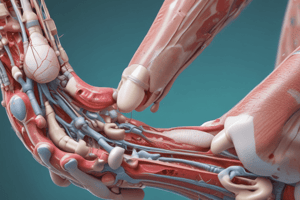Podcast
Questions and Answers
What does amputation refer to?
What does amputation refer to?
Surgical cutting of a limb.
What are the two major categories of amputation?
What are the two major categories of amputation?
- Traumatic Amputation
- Infection-related Amputation
- Acquired Amputation (correct)
- Congenital Amputation (correct)
The prevalence of amputation is greater in LE (lower extremity) than in UE (upper extremity) with a ratio of _____.
The prevalence of amputation is greater in LE (lower extremity) than in UE (upper extremity) with a ratio of _____.
5:1
Peripheral Vascular Disease is the most common cause of upper extremity amputation.
Peripheral Vascular Disease is the most common cause of upper extremity amputation.
Which of the following methods can achieve muscle stabilization?
Which of the following methods can achieve muscle stabilization?
What is the primary cause for performing amputation in cases of infection?
What is the primary cause for performing amputation in cases of infection?
What is the common method of achieving hemostasis during amputation?
What is the common method of achieving hemostasis during amputation?
Flashcards are hidden until you start studying
Study Notes
Definition of Amputation
- Amputation is the surgical removal of a limb due to non-functional conditions caused by injury or disease.
- Types of amputation are determined by the surgeon based on the extremity's condition.
- Goals include enabling primary or secondary wound healing and creating a functional residual limb for prosthetic fitting.
Categories of Amputation
- Acquired Amputation
- Loss of limb part or whole due to trauma or surgical intervention.
- May involve revision of congenital amputations or correction of deformities from trauma or burns.
- Congenital Amputation
- Limb loss occurs in utero, often linked to factors like drug toxicity.
- Resulting from failure in limb bud formation or umbilical cord strangulation.
Epidemiology
- Amputation is more prevalent in lower extremities (LE) than upper extremities (UE), with a ratio of 5:1.
- Higher incidence in males compared to females.
- Peripheral vascular disease is the most common cause of lower extremity amputations.
- Trauma is the primary cause of upper extremity amputations.
Etiology
- Congenital Anomaly
- Observed absence or abnormality of limbs present at birth.
- Peripheral Vascular Disease
- Caused by embolism or thrombosis leading to ischemia, necrosis, gangrene, or ulceration.
- Trauma
- Severe injury necessitating amputation when function cannot be restored.
- Infection
- Amputation may be performed to prevent further spread when infections resist medical treatment.
- Tumor
- Required for treatment of primary malignant tumors that are unresponsive to other interventions.
Muscle Stabilization Techniques
- Essential for maximizing limb function and facilitating proper prosthetic fitting.
- Techniques include:
- Myofascial closure: Muscle attached to fascia.
- Myoplasty: Muscle attached to muscle.
- Myodesis: Muscle attached to bone.
- Tenodesis: Tendon attached to bone.
- Muscle stabilization needs to maintain tension at all levels where transected.
Neuromas
- Result from severed peripheral nerves, forming collections of nerve endings in residual limbs.
- Proper soft tissue surrounding is necessary to prevent pain and facilitate prosthetic use.
Hemostasis
- Achieved by ligating major veins and arteries.
- Cauterization is reserved for minor bleeding.
- Bone ends are beveled to decrease pressure on the prosthetic socket during healing.
Healing Process
- Healing of the residual limb involves phases such as:
- Inflammatory stage: Initial response to trauma and surgery.
Studying That Suits You
Use AI to generate personalized quizzes and flashcards to suit your learning preferences.




